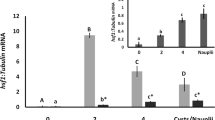Summary
We have used isotopic labelling and both one-and two-dimensional electrophoretic procedures to analyse the protien synthesis patterns in oocytes and early embryos of three phenotypes of the European green frogs. The results demonstrated that protein patterns of Rana ridibunda and R. esculenta are identical, but that they differ from those of R. lessonae. Progeny of the lethal cross R. esculenta × R. esculenta showed a distinct delay in the appearance of stage-specific proteins during early embryogenesis. The heat-shock response of R. ridibunda and R. esculenta oocytes was found to be identical, but different from that of Xenopus laevis. The implications of these findings, with respect to hybridogenesis in R. esculenta complex and variations in the regulations of heat shock genes in different amphibian species, are discussed.
Similar content being viewed by others
References
Ballantine JEM, Woodland HR, Sturgess EA (1979) Changes in protein synthesis during the development of Xenopus laevis. J Embryol Exp Morphol 51:137–153
Barth LG, Barth LJ (1959) Differentiation of cells of the Rana pipiens gastrula in unconditioned medium. J Embryol Exp Morphol 7:710–722
Berger L (1983) Western palearctic water frogs (Amphibia, Ranidae): Systematics, genetics and population compositions. Experientia 39:127–130
Bienz M (1982) The heat-shick response in Xenopus oocytes and somatic cells: Differences in phenomena and control. In: Schlesinger MJ, Ashburner M, Tissières A (eds) Heat shock from bacteria to man. Cold Spring Harbor Laboratory, New York, pp 177–181
Bienz M (1984) Developmental control fo the heat shock response in Xenopus. Proc Natl Acad Sci [USA] 81:3138–3142
Bienz M, Gurdon JB (1982) The heat shock repsonse in Xenopus oocytes is controlled at the translational level. Cell 29:811–819
Binkert J, Borner P, Chen PS (1982) Rana esculenta complex: An experimental analysis of lethality and hybridogenesis. Experientai 38:1283–1292
Bravo R, Knowland J (1979) Classes of proteins synthesized in oocytes, eggs, embryos, and differentiated tissues of Xenopus laevis. Differentiation 13:101–108
Brock HW, Reeves R (1978) An investigation of de novo protein synthesis in the south African clawed frog, Xenopus laevis. Dev Biol 66:128–141
Davidson EH (1976) Gene activity in early development. Academic Press, New York, pp 59–83
Dumont JN (1972) Oogenesis in Xenopus laevis (Daudin): I. Stages of oocyte development in laboratory maintained animals. J Morphol 136:153–180
Gurdon JB (1967) African clawed frogs. In: Wilt F, Wessels NK (eds) Methods in developmental biology. Crowell TY, New York, pp 75–84
Heppich S, Tunner HG, Greihuber J (1982) Premeiotic chromosome doubling after genome elimination during spermatogenesis of the species hybrid Rana esculenta. Theo Appl Genet 61:101–104
Laemmli UK (1970) Cleavage of structural proteins during the assembly of the head of the bacteriophage T4. Nature [Lond] 227:680–685
Meuler DC, Malacinski GM (1984) Protein synthesis patterns during early amphibian embryogenesis. In: Malacinski GM, Klein WH (eds) Molecular aspects of early development. Plenum Press, New York & London, pp 267–288
Newport J, Kirschner M (1982) A major developmental transition in early Xenopus embryos: II. Control of onset of transcription. Cell 30:687–696
O'Farrell PH (1975) High resolution two-dimensional electrophoresis. J Biol Chem 250:4007–4021
O'Farrell PZ, Goodman HM, O'Farrell PH (1977) High resolution two-dimensional electrophoresis of basic as well as acidic Proteins. Cell 12:1133–1142
Rugh R (1948) Experimental embryology. Burgess, Minneapolis.
Schlesinger MJ, Ashburner M, Tissières A (eds) (1982) Heat shock from bacteria to man. Cold Spring Harbor Laboratory, New York
Spemann H (1936) Experimentelle Beiträge zu einer Theorie der Entwicklung. Springer, Berlin
Tunner HG (1970) Das Serumeiweißbild einheimischer Wasserfrösche und der Hybridcharakter von Rana esculenta. Verh. Deutsch Zool Ges 64:352–358
Tunner HG (1973) Das — Albumin und andere Bluteiweiß bei Rana ridibunda Pallas, Rana lessonae Camerano, Rana esculenta Linné und deren Hybriden. Z Zool Syst Evolut-Forsch ii:219–233
Tunner HG, Heppisch S (1981) Premeiotic genome exclusion during oogenesis in the common edible frog, Rana esculenta. Naturwissenschaften 68:207–208
Vogel P (1973) Elektrophoretische Untersuchungen der Serumproteine von Grünfröschen aus dem Rana esculenta-Komplex. Diplomarbeit, University of Zürich
Vogel P, Chen PS (1976) Genetic control of LDH isozymes in the Rana esculenta complex. Experientia 32:304–307
Vogel P, Chen PS (1977) A further study of LDH isozymes in the Rana esculenta complex. Experientia 33:1285–1287
Author information
Authors and Affiliations
Rights and permissions
About this article
Cite this article
Chen, P.S., Stumm-Zollinger, E. Patterns of protein synthesis in oocytes and early embryos of Rana esculenta complex. Roux's Arch Dev Biol 195, 1–9 (1986). https://doi.org/10.1007/BF00444035
Received:
Accepted:
Issue Date:
DOI: https://doi.org/10.1007/BF00444035




